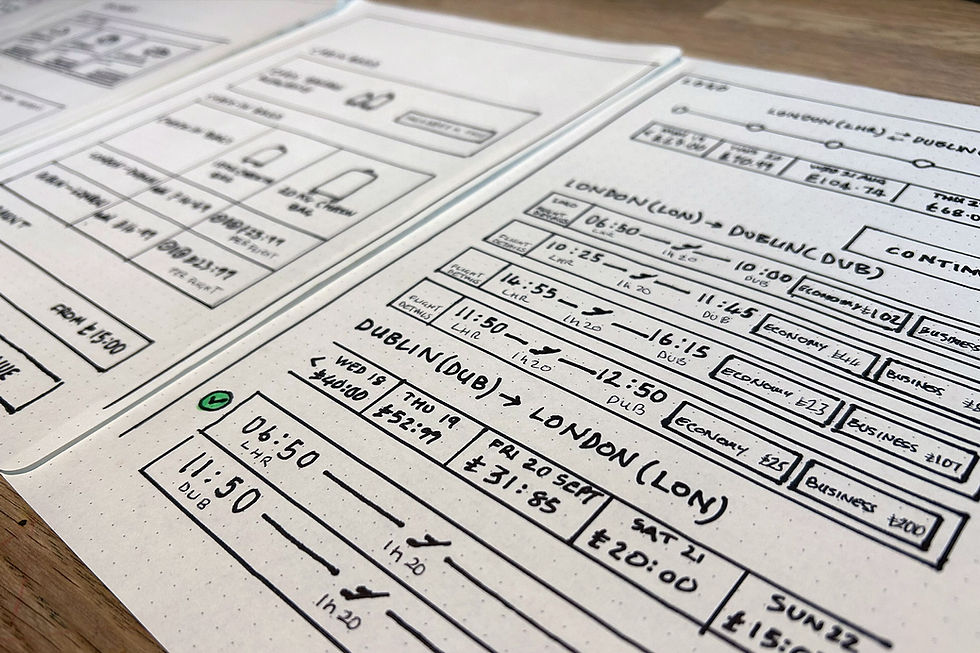



Simplifying the Flight Booking Experience
My Role | Duration | Software Used |
|---|---|---|
UX Design | 4 Months | Miro |
UI Design | Figma/
Creative Suite | |
AI Integration | Pen and Paper |
My Role | Duration | Software Used |
|---|---|---|
UX Design | 4 Months | Miro |
UI Design | Figma/
Creative Suite | |
AI Integration | Pen and Paper |
Overview
Flyt is a speculative redesign of a flight-booking platform created to address real user frustrations found in industry-leading sites. The goal was to make booking faster, clearer, and more intuitive — cutting through the clutter that often overwhelms travellers.
I worked through all stages of the UX process, from discovery research to high-fidelity prototyping, using both qualitative and competitive research methods.

The Challenge
Design a new flight-booking app that could compete with “best-in-class” travel sites, focusing on the journey from homepage to checkout. The aim: remove confusion, reduce unnecessary steps, and guide users seamlessly to purchase.

Research & analysis activities
Methods used:
-
Competitive benchmarking of major booking platforms
-
Remote usability testing
-
Qualitative analysis
-
Customer journey mapping and flow diagrams
Key findings:
-
Ambiguous CTAs & unclear field labels slowed task completion.
-
Pop-ups and drop-downs often obscured the main search field, creating immediate friction.
-
Duplicate page layouts for outbound/return fares led to user confusion.
-
No smart defaults — users repeatedly entered location and language preferences.
-
Extras pages caused mistrust and friction (“hidden fees?”).
Problem Statement
Users struggle to move confidently through flight booking flows due to cluttered interfaces, unclear guidance, and unnecessary repetition.

A Customer Journey Map became the focus of the new design and was constantly referred to during the iteration process

A Customer Journey Map became the focus of the new design and was constantly referred to during the iteration process
Design Approach
Grounded in the research, I defined an ideal booking flow that prioritised clarity, guidance, and speed.
Core design decisions:
-
Smart defaults: Auto-detect returning users and location settings to skip redundant steps.
-
Guided progression: Highlight “next step” fields with clear CTAs and visual feedback.
-
Minimal layout: No obstructive ads or drop-downs; focused purely on booking flow.
-
Animated feedback: Smooth transitions signal task completion and progression.
-
Progressive disclosure: Show only essential information at each stage to reduce overload.
The result: a faster, simpler “A-to-B” journey through booking with fewer clicks and less confusion.

Using user recognition and assumptions flow starts at the 'Where to' field. Flyt uses minimum clicks through the search box process, guiding the user.

Design ideas started with sketching out and iterating possible approaches based on the research and the flow diagram. Mid and High-Fidelity prototypes were then created.


A flow diagram was created to work out the optimum journey through the booking process

Outcome
Using insights from my mid-fidelity prototype testing, I developed a high-fidelity prototype to validate usability and interaction flow.
Feedback indicated that users:
-
Found it easier to identify their next step
-
Completed the flow faster with fewer errors
-
The pared-back ad-free layout benefited their focus (no distractions from the main task)
The current prototype focuses on clarity and functional flow, setting the foundation for future usability testing and accessibility refinement..

Next Steps
-
Conduct larger-scale usability testing to validate assumptions.
-
Integrate accessibility compliance (WCAG 2.2).
-
Explore integration of AI-based user recognition for smart defaults.

